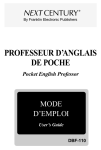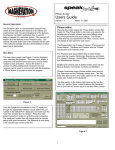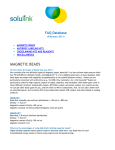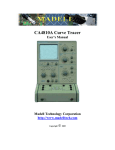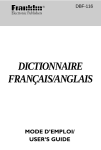Download Teacher`s Guide
Transcript
TEACHER MANUAL Pronunciation Power www.englishlearning.com [email protected] PROGRAM LEVEL • Pronunciation Power 2 is geared to Intermediate to Advanced ESL /EFL learners. Pronunciation Power 1 is geared to Beginner to Intermediate ESL/EFL learners. • These programs are excellent tools for teachers of ESL to compliment their classroom learning environment by aiding the students in practicing and improving their pronunciation skills through self-study. They are best used as self study tools. The teacher can direct the student as to the Lessons that would be best for them to study and then the program is designed for the student to be able to go ahead and practice on their own. Following are instructions for how to instruct the students to use the programs as their personal pronunciation aid. PROGRAM BENEFITS • Research has shown that other programs tried to cover too many concepts which resulted in them being too complex. There was too much of a learning curve for students to learn how to use the program itself rather than program content. Pronunciation Power products are extremely user friendly: - they deal with pronunciation directly ( although spelling, reading and listening are dealt with indirectly). - there are very few icons to understand and the icons stay the same throughout the program. - a help button and reminder button is available on each screen. - they are not linear programs, students can move to whatever section they wish whenever they wish. • They contain 1000’s of hours of listening time alone. • There are over 1800 individual practice words as well as 1200 practice sentences. • Listening for intonation – students can listen as often as they want to the voice of the instructor throughout the program. • Spelling is dealt with indirectly but extremely effectively through the use of the toggle button, which highlights the sound in the word that the students is working on. The toggle button is shown on the screen as two circle side by side. Click on one circle and the sounds highlight in the words. Click on the other and the highlights are removed. English spelling is very obscure. George Bernard Shaw once gave an example of how much: What does this word say "ghoti"? ( answer- "fish" - "gh" as in rough " o" as in women "ti" as in nation • These products are self-monitoring. It is important for the student to be able to evaluate his/her own mistakes and correct them. It is important he/she learns to hear the difference of his/her pronunciation compared to correct pronunciation. This program allows as much practice as a student wishes. • Important note: not all linguistic possibilities are dealt with in this program i.e.) "o" difference in "cot"/"caught" : flaps: different tongue positions for the g and k sounds ( back of hard palate or on the soft palate depending on what vowel follows it). These fine linguistic differences are not a concern to second language learners so we have focused on sounds that will make them understandable - the most predominant sounds and sound difficulties i.e.)cut/cot. This is a userfriendly program that deals with the most significant sounds - any more and the program would be too complex or require too much memory PRONUNCIATION POWER TEACHER GUIDE USER MANUAL There is a detailed teacher manual available with each product. Pronunciation Power 2 has an additional teacher’s manual that explains suprasegmentals: the S.T.A.I.R manual. LESSONS Note to teacher: The students will go to the Lesson of the sound that they are needing/wanting to correct or improve. - Each button is linked to instructional help at the bottom of the page so the student should be able to use the program without much teacher interaction. - Sounds are grouped according to groups of sounds or sound pairs that English learners struggle with i.e.) b is voiced whereas p is not (same mouth position). - Once in a particular Lesson the students can go to whichever Exercise they choose after completing the Lesson.: Sample words, Listening Discrimination, Comparative words, S.T.A.I.R, Sample sentences. Pronunciation Power 1 also has the option of an interactive dictionary and 4 interactive games. - A teacher can have the student save their recordings. This feature can be used as a test of progress or as teacher review of student work. LESSON GUIDE The teacher may want to introduce Pronunciation Power products Lessons in the following way: Side View: • Point out the voice box and air flow. Discuss the airflow legend on the right of the screen. Advanced information on this is available in the on program manual. • Show that animated movement is made by clicking on the play button or on the animation. • Show the slow motion ( frame by frame) process of seeing graphic movement. Show how mouth or tongue position can shown in all positions. • Description - point out that student can read about or listen to how the sound is made. (PP2 only) • Click on the Side View Legend to demonstrate the diagrammed mouth in detail. It is effective to show this after the student has listened to the description screen and a word like "hard palate" has been used. (PP2 only) Front View: This is a video of lip movement for each sound. • Show the movement of the lips by clicking on the play button. • A female voice is used so students can hear how the sound is a little different for each individual. • Demonstrate the Suggestion: with each front view (in Pronunciation Power 2 only). It focuses on specific sound difficulties some language groups may have i.e.) l/r or iy/I for Chinese speakers. Speech Analysis: It is very important to read the manual section about speech analysis. Learn how to read wave forms well. Know how to recognize such things as background noise or variances in volume and tone etc. To the teacher: • This is a visual TOOL. It is impossible to get a perfect match but the student should try to have their wave form as closely math the shaded area as possible. The student must use the listening (auditory) component as well. • Students learn how to read wave forms when they practice. Practice includes listening and comparing their voice with that of the instructor's as well as the wave form. • Poor pronunciation can only be changed by practice. Students are motivated by this mode of practice. Stress that it is good for students to keep practicing - they get better, lose their inhibition to speak, and with this tool they aren't embarrassed as they can be in a group/class setting. • The wave form is used only for phonemes. During development we tested wave forms with sentences, comparative words and single words - it was much too difficult for students to analyze. • Demonstrate how the “pointer hand” can be used to align the recorded wave form into the shaded area. Advanced information on this is available in the on program manual. EXERCISES GUIDE The content of the Exercises contain a broad range of vocabulary and themes. The vocabulary and reading level is much higher with Pronunciation Power 2 than Pronunciation Power 1. The teacher may want to introduce Pronunciation Power Exercises in the following way: • Reinforce the fact that students can practice and listen as much as they desire without depending on someone else and without embarrassment. Through practice in recording all of the exercises their pronunciation will improve. Encourage them to listen carefully to the differences between their own recordings and that of the instructor’s. After hearing the differences they should then try again and try to come as close as possible to the sound of the instructor. Note to teachers: Translations are available for all help and vocabulary in Pronunciation Power 1 only. In Pronunciation Power 1 if the students have chosen another language they may hold the pointer hand over a word to have the translation of that word at the bottom of the screen. Sample Words: The sound the student is working on has the following position in the word: - first column - sound is at the beginning of the word - second column - sound is in the middle of the word - third column - sound is at the end of the word • The student will listen to the words and then record their own voice. They will then listen and compare their recordings to that of the instructor’s. The teacher can have the students save their recordings in their own folder on the desktop. Advanced information on this is available in the on program manual. Listening Discrimination: The students must be able to hear sound differences to be able to say them. This exercise will help improve their listening skills. Both words fit into the context of the sentence so the student cannot figure out the correct word through reading, they must listen. The two choice words in the sentence randomly switch position therefore the student cannot memorize the correct sequence, they must listen. • The students will listen to the instructor and choose which word he said by clicking on it. If they are correct a green check mark will appear. If they are incorrect a red cross will appear. Pronunciation Power 1 only: The students can click on the instructor's recording of the two words (below the two words) if they want to hear both words. Listening Discrimination B (in Pronunciation Power 1 only) • The students must listen to the instructor and decide if the two words they hear have the same practice sound in them. They must choose yes or no. Comparative Words: (also known as minimal pairs) These are paired in sound similarities that students struggle with i.e.) iy/I l/r g/k g/d etc. • The student will listen to the words and then record their own voice. They will then listen and compare their recordings to that of the instructor’s. The teacher can have the students save their recordings in their own folder on the desktop. Sentences: There is a 20 second record limit for the sentences. As the sentences get longer students must phrase or group to get through the sentence in time. With practice this becomes natural. These sentences provide ample opportunity for the user to listen for intonation. • The students will listen to the words and then record their own voice. They will then listen and compare their recordings to that of the instructor’s. The teacher can have the students save their recordings in their own folder on the desktop. Advanced information on this is available in the on program manual. • Reinforce the use of the toggle button to highlight the sounds that they are working on. Note to teachers: For all exercises other than Listening Discrimination note the following extremely important features: • The toggle button is beneficial for teaching or demonstrating spelling in 2 ways - a) teaches spelling indirectly i.e.) uw can be spelt 8 different ways: too, to, two, through, sue, shoe, suit, new. This can be seen by demonstrating it in a sentence with the toggle button on and off. b) teaches spelling directly : give a sample idea such as - Have students listen to the sentence without sounds highlighted. Write down which words have the sound that the student is working on. The student can check his/her own work by turning on the toggle button. Reinforce the value of this button. S.T.A.I.R. – This unit of exercises is developed for the student to practice several speaking skills. S- Stress in words. Large dot shows strong stress. Small dot shows weak or no stress. T - Timing - Watch the highlights on the words move with the instructor's voice. Record your voice along with the moving highlights. A - Articulation - Words are often shortened when they are linked to other words. This is shown with a curved line above the words. I - Intonation and pitch. These voice changes are shown with arrows. R - Rhythm. Watch the highlights as with timing. • The students will listen to each sentence and watch the moving highlights and the symbols. Record along with the highlights. 8 in 1 English Pronunciation Dictionary (also included in Pronunciation Power 1) Note to teachers: Have the students use this dictionary to improve their pronunciation through various detailed searches of words. This dictionary is a self study tool and is best used after the teacher has shown the students all of the variety of uses of the tool. Translations are available for all instructions and buttons and vocabulary. Root words are words shown in their simplest form. Translations for nouns (N) and verbs (V) are available in the root word only. The forms (plurals) of all of the nouns (N) in this program are available. They will appear on the “Center list” when you search by Sound or Text. The forms (plurals) will appear in the “Details box” when a word that is a noun is selected for detailed viewing and practice. The forms (conjugations) of all of the verbs (V) in this program are available. They will appear on the “Center list” when you search by Sound or Text. The forms (conjugations) will appear in the “Details box” when a word that is a verb is selected for detailed viewing and practice. Some English words do not have a suitable translation in your language. You will see "No translation available." instead of a translation. Help bar: The instructions appear in this bar when the students drag the cursor over a button or functional area. Search/Find area: This is the area where the students can chose to find words according to various search options. 1. Search by alphabet. Click on the tab that says "Alphabet". Click on one of the letters of the alphabet to show all of the words that begin with that letter. This search will show root words in the center list. 2. Search by sounds that appear in words. Click on the tab that says "Sound". Hold on the arrow to see the selection of sounds. Listen to each of the sounds by dragging the cursor to each one. Click on any one of the 52 sounds available. Chose, by clicking the button, to have the sound located at the beginning of the words only, end of the words only or anywhere in the word. This search will show the root words and their forms in the Center list. 3. Search by text. Click on the tab that says "Text". Type in the box. Chose, by clicking the button, to have the words listed that "Start with", "End with" or "Contain" the letters typed in the box. An entire word can be found by typing the word and choosing "Exactly match". This search will show the root words and their forms in the Center list. 4. Click on "All Words" to search for all of the root words in the dictionary. 5. Click on "Nouns" to show all of the nouns available in the program. 6. Click on "Verbs" to show all of the verbs available in the dictionary. 7. Click on "Other" to show all of the words that are not nouns or verbs. 8. Search by Theme. There are 39 themes in this dictionary. Click on the theme button. Click on one of the themes to show all of the words available in that theme. This search will show the root words in the Center list. These searches will show the root words in the Center list. Center list - The "Center list" shows the list of words that are the result of the search that was performed in the "Search/Find area". Click on a word on the list to hear it. Click on a word for it to appear in the "Details box". Scroll through all of the words by using the scroll bar. Details box - The "Details box" shows the details of a word chosen from the "Center list". The details include: a large picture (if there is a picture available), a sample sentence using the word, listening and record and play back features, as well as conjugations of the verbs and plurals of the nouns. Click on a word to hear it. Click on this button to record your voice. Click on this button to stop the recording. Click on this button to listen to your recording. The sample sentence is for reading only, there is no sound available. The final self-help practice is through the games unit (Pronunciation Power 1 only). After the students have completed the Lessons and Exercises for a particular unit they will enjoy the fun-filled practice of any one of the 4 interactive games. All instructions are available on screen and are easy to understand. The games are easy to learn. VOCABULARY articulation - manner of obstructing air flow (air flow is described in detail in the user manual) articulators - bottom lip, bottom teeth, tongue, jaw aspiration - burst of air which happens with voiceless sounds p, t, k in certain positions in a word auditory - anything requiring listening aural - listening blend - sounds flowing together i.e.) isn't it iznit consonant cluster - 2 or more consonants together. Do not confuse with single phonemes that are written with 2 symbols i.e.) th, sh, ph, ch diphthongs - complex vowel sound created by a vowel and semi-vowel together i.e.) (oy),boy (ey), bait (ay) buy flap - variant of the "t" sound which occurs between 2 vowels. It actually sounds like "d" i.e.) butter budder We do not address flaps in this program. intonation - rise and fall of pitch in a sentence IPA symbols - International Phonetic Alphabet - we use some of these symbols for the 52 sounds and some of our own. The symbol for the sound chosen is always shown in the top right hand corner of each screen. linking - blending of words in a phrase also known as phrasing or grouping. This concept is dealt with in sentence exercises (note further comments on this in the rest of this manual) minimal pairs / comparative words - words that differ in only 1 sound g-d as in gone/Don g - k - as in dog / dock i.e.) oral - speaking phonemes - individual sounds phonetics - study of speech sounds pitch - frequency of vibration of voice. Issues around stress, pitch, intonation, rhythm are dealt with in sentences. reduced vowels /vowel reduction - in natural speech we often drop ending vowels to flow to the next word i.e.) I'm going to the store. I'm going t'the store. This concept is dealt with in the S.T.A.I.R reduction - in relaxed speech sounds are reduced or dropped schwa - " ∂ " sound (as in but) segmental - individual sounds supra segmental - aspects of speech above the level of individual sound, includes rhythm, stress, intonation, phrasing semi-vowels - w and y stress - emphasis on a syllable or word voicing - note manual for explanation of voiced and voiceless Note: Glossary in manual contains further vocabulary www.englishlearning.com [email protected]








